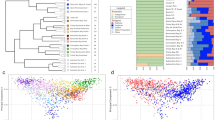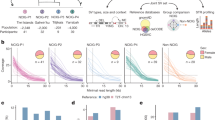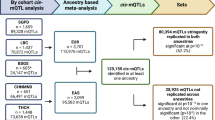Abstract
The density of genetic markers required for successful association mapping of complex diseases depends on linkage disequilibrium (LD) between non-functional markers and functional variants. The haplotypic relationship between stable markers and potentially unstable but highly informative markers (e.g. microsatellites) indicates that LD might be maintained over considerable genetic distance in non-African populations, supporting the use of such ‘mixed marker haplotypes’ in LD-based mapping, and allowing inferences to be drawn about human origins. We investigated sequence variation in the proximal 2.6 kb of the inducible nitric oxide synthase (NOS2A) promoter and the relationship between SNP haplotypes and a pentanucleotide microsatellite (the ‘NOS2A−2.6 microsatellite’) in Gambians and UK Caucasians. UK Caucasians exhibited a subset of sequence diversity observed in Gambians, sharing four of 11 SNPs and a similar haplotypic structure. Five SNPs were found in the sequence of interspersed repetitive DNA elements. In both populations, there was dramatic loss of LD between SNP haplotypes and microsatellite alleles across a very short physical distance, suggesting a high intrinsic mutation rate of the NOS2A−2.6 microsatellite, the SNP haplotypes are relatively ancient, or that this was a region of frequent recombination. Understanding locus- and population-specific LD is essential when designing and interpreting genetic association studies.
This is a preview of subscription content, access via your institution
Access options
Subscribe to this journal
Receive 6 digital issues and online access to articles
$119.00 per year
only $19.83 per issue
Buy this article
- Purchase on Springer Link
- Instant access to full article PDF
Prices may be subject to local taxes which are calculated during checkout




Similar content being viewed by others
References
Risch N, Merikangas K . The future of genetic studies of complex human diseases. Science 1996; 273: 1516–1517.
Sawcer S, Maranian M, Setakis E et al. A whole genome screen for linkage disequilibrium in multiple sclerosis confirms disease associations with regions previously linked to susceptibility. Brain 2002; 125: 1337–1347.
Houwen RH, Baharloo S, Blankenship K et al. Genome screening by searching for shared segments: mapping a gene for benign recurrent intrahepatic cholestasis. Nat Genet 1994; 8: 380–386.
Jorde LB . Linkage disequilibrium as a gene-mapping tool. Am J Hum Genet 1995; 56: 11–14.
Kruglyak L . Prospects for whole-genome linkage disequilibrium mapping of common disease genes. Nat Genet 1999; 22: 139–144.
Weiss KM, Clark AG . Linkage disequilibrium and the mapping of complex human traits. Trends Genet 2002; 18: 19–24.
Terwilliger JD, Weiss KM . Linkage disequilibrium mapping of complex disease: fantasy or reality? Curr Opin Biotechnol 1998; 9: 578–594.
Kruglyak L . Genetic isolates: separate but equal? Proc Natl Acad Sci USA 1999; 96: 1170–1172.
Phillips MS, Lawrence R, Sachidanandam R et al. Chromosome-wide distribution of haplotype blocks and the role of recombination hot spots. Nat Genet 2003; 33: 382–387.
Clark AG, Weiss KM, Nickerson DA et al. Haplotype structure and population genetic inferences from nucleotide- sequence variation in human lipoprotein lipase. Am J Hum Genet 1998; 63: 595–612.
Zabetian CP, Buxbaum SG, Elston RC et al. The Structure of linkage disequilibrium at the DBH locus strongly influences the magnitude of association between diallelic markers and plasma dopamine beta-hydroxylase activity. Am J Hum Genet 2003; 72: 1389–1400.
Sachidanandam R, Weissman D, Schmidt SC et al. A map of human genome sequence variation containing 1.42 million single nucleotide polymorphisms. Nature 2001; 409: 928–933.
Taillon-Miller P, Bauer-Sardina I, Saccone NL et al. Juxtaposed regions of extensive and minimal linkage disequilibrium in human Xq25 and Xq28. Nat Genet 2000; 25: 324–328.
Nakajima T, Jorde LB, Ishigami T et al. Nucleotide diversity and haplotype structure of the human angiotensinogen gene in two populations. Am J Hum Genet 2002; 70: 108–123.
Eaves IA, Merriman TR, Barber RA et al. The genetically isolated populations of Finland and Sardinia may not be a panacea for linkage disequilibrium mapping of common disease genes. Nat Genet 2000; 25: 320–323.
Wilson JF, Goldstein DB . Consistent long-range linkage disequilibrium generated by admixture in a bantu-semitic hybrid population. Am J Hum Genet 2000; 67: 926–935.
Daly MJ, Rioux JD, Schaffner SF, Hudson TJ, Lander ES . High-resolution haplotype structure in the human genome. Nat Genet 2001; 29: 229–232.
Boehnke M . A look at linkage disequilibrium. Nat Genet 2000; 25: 246–247.
Kruglyak L . The use of a genetic map of biallelic markers in linkage studies. Nat Genet 1997; 17: 21–24.
Mohlke KL, Lange EM, Valle TT et al. Linkage disequilibrium between microsatellite markers extends beyond 1 cM on chromosome 20 in Finns. Genome Res 2001; 11: 1221–1226.
Merriman TR, Eaves IA, Twells RC et al. Transmission of haplotypes of microsatellite markers rather than single marker alleles in the mapping of a putative type 1 diabetes susceptibility gene (IDDM6). Hum Mol Genet 1998; 7: 517–524.
Feder JN, Gnirke A, Thomas W et al. A novel MHC class I-like gene is mutated in patients with hereditary haemochromatosis. Nat Genet 1996; 13: 399–408.
Ota M, Mizuki N, Katsuyama Y et al. The critical region for Behcet disease in the human major histocompatibility complex is reduced to a 46-kb segment centromeric of HLA-B, by association analysis using refined microsatellite mapping. Am J Hum Genet 1999; 64: 1406–1410.
Davoodi-Semiromi A, Yang JJ, She JX . IL-12p40 is associated with type 1 diabetes in Caucasian-American families. Diabetes 2002; 51: 2334–2336.
Barcellos LF, Klitz W, Field LL et al. Association mapping of disease loci, by use of a pooled DNA genomic screen. Am J Hum Genet 1997; 61: 734–747.
Johnson GC, Esposito L, Barratt BJ et al. Haplotype tagging for the identification of common disease genes. Nat Genet 2001; 29: 233–237.
Tishkoff SA, Dietzsch E, Speed W et al. Global patterns of linkage disequilibrium at the CD4 locus and modern human origins. Science 1996; 271: 1380–1387.
Tishkoff SA, Goldman A, Calafell F et al. A global haplo-type analysis of the myotonic dystrophy locus: implications for the evolution of modern humans and for the origin of myotonic dystrophy mutations. Am J Hum Genet 1998; 62: 1389–1402.
Kidd KK, Morar B, Castiglione CM et al. A global survey of haplotype frequencies and linkage disequilibrium at the DRD2 locus. Hum Genet 1998; 103: 211–227.
Tishkoff SA, Pakstis AJ, Stoneking M et al. Short tandem-repeat polymorphism/Alu haplotype variation at the PLAT locus: implications for modern human origins. Am J Hum Genet 2000; 67: 901–925.
Burgner D, Rockett K, Kwiatkowski D . Nitric oxide and infectious diseases. Arch Dis Child 1999; 81: 185–188.
Nathan C . Inducible nitric oxide synthase: what difference does it make? J Clin Invest 1997; 100: 2417–2423.
Anggard E . Nitric oxide: mediator, murderer, and medicine. Lancet 1994; 343: 1199–1206.
Muijsers RBM, Folkerts G, Henricks PA, Sadeghihashjin G, Nijkamp FP . Peroxynitrite: a two-faced metabolite of nitric oxide. Life Sci 1997; 60: 1833–1845.
De Vera ME, Shapiro RA, Nussler AK et al. Transcriptional regulation of human inducible nitric oxide synthase (NOS2) gene by cytokines: initial analysis of the NOS2 promoter. Proc Natl Acad Sci USA 1996; 93: 1054–1059.
Taylor BS, de Vera ME, Ganster RW et al. Multiple NF-kappaB enhancer elements regulate cytokine induction of the human inducible nitric oxide synthase gene. J Biol Chem 1998; 273: 15148–15156.
Kun JF, Mordmuller B, Lell B, Lehman LG, Luckner D, Kremsner PG . Polymorphism in promoter region of inducible nitric oxide synthase gene and protection against malaria. Lancet 1998; 351: 265–266.
Burgner D, Usen S, Rockett K et al. Nucleotide and haplotypic diversity of the NOS2A promoter region and its relationship to cerebral malaria. Hum Genet 2003; 112: 379–386.
Xu W, Liu L, Emson PC, Harrington CR, Charles IG . Evolution of a homopurine–homopyrimidine pentanucleotide repeat sequence upstream of the human inducible nitric oxide synthase gene. Gene 1997; 204: 165–170.
Burgner D, Xu W, Rockett K et al. Inducible nitric oxide synthase polymorphism and fatal cerebral malaria. Lancet 1998; 352: 1193–1194.
Warpehia KM, Xu W, Liu L et al. Genotyping and functional analysis of a polymorphic (CCTTT)n repeat of NOS2A in diabetic retinopathy. FASEB J 1999; 13: 1825–1832.
Xu W, Liu L, Emson P et al. The CCTTT polymorphism in the NOS2A gene is associated with dementia with Lewy bodies. Neuroreport 2000; 11: 297–299.
Rutherford S, Johnson MP, Curtain RP, Griffiths LR . Chromosome 17 and the inducible nitric oxide synthase gene in human essential hypertension. Hum Genet 2001; 109: 408–415.
Hobbs MR, Udhayakumar V, Levesque MC et al. A new NOS2 promoter polymorphism associated with increased nitric oxide production and protection from severe malaria in Tanzanian and Kenyan children. Lancet 2002; 360: 1468–1475.
Cargill M, Altshuler D, Ireland J et al. Characterization of single-nucleotide polymorphisms in coding regions of human genes. Nat Genet 1999; 22: 231–238.
Jorde LB, Bamshad M, Rogers AR . Using mitochondrial and nuclear DNA markers to reconstruct human evolution. BioEssays 1998; 20: 126–136.
Armour JA, Anttinen T, May CA et al. Minisatellite diversity supports a recent African origin for modern humans. Nat Genet 1996; 13: 154–160.
Bowcock AM, Ruiz-Linares A, Tomfohrde J, Minch E, Kidd JR, Cavalli-Sforza LL . High resolution of human evolutionary trees with polymorphic microsatellites. Nature 1994; 368: 455–457.
Harpending HC, Batzer MA, Gurven M, Jorde LB, Rogers AR, Sherry ST . Genetic traces of ancient demography. Proc Natl Acad Sci USA 1998; 95: 1961–1967.
Halushka MK, Fan JB, Bentley K et al. Patterns of single-nucleotide polymorphisms in candidate genes for blood-pressure homeostasis. Nat Genet 1999; 22: 239–247.
Nei M . Evolution of human races at the gene level. Prog Clin Biol Res 1982; 103: 167–181.
Nadir E, Margalit H, Gallily T, Ben-Sasson SA . Microsatellite spreading in the human genome: evolutionary mechanisms and structural implications. Proc Natl Acad Sci USA 1996; 93: 6470–6475.
Arcot SS, Wang Z, Weber JL, Deininger PL, Batzer MA . Alu repeats: a source for the genesis of primate microsatellites. Genomics 1995; 29: 136–144.
Mighell AJ, Markham AF, Robinson PA . Alu sequences. FEBS Lett 1997; 417: 1–5.
Freimer NB, Slatkin M . Microsatellites: evolution and mutational processes. Ciba Found Symp 1996; 197: 51–67.
Kayser M, Roewer L, Hedman M et al. Characteristics and frequency of germline mutations at microsatellite loci from the human Y chromosome, as revealed by direct observation in father/son pairs. Am J Hum Genet 2000; 66: 1580–1588.
Chakraborty R, Kimmel M, Stivers DN, Davison LJ, Deka R . Relative mutation rates at di-, tri-, and tetra-nucleotide microsatellite loci. Proc Natl Acad Sci USA 1997; 94: 1041–1046.
Weber JL, Wong C . Mutation of human short tandem repeats. Hum Mol Genet 1993; 2: 1123–1128.
Chambers GK, MacAvoy ES . Microsatellites: consensus and controversy. Comp Biochem Physiol B 2000; 126: 455–476.
Wainscoat JS, Hill AV, Boyce AL et al. Evolutionary relationships of human populations from an analysis of nuclear DNA polymorphisms. Nature 1986; 319: 491–493.
Rogers AR, Jorde LB . Genetic evidence on modern human origins. Hum Biol 1995; 67: 1–36.
Brook JD, McCurrach ME, Harley HG et al. Molecular basis of myotonic dystrophy: expansion of a trinucleotide (CTG) repeat at the 3′ end of a transcript encoding a protein kinase family member. Cell 1992; 68: 799–808.
Ohashi J, Naka I, Patarapotikul J, Hananantachai H, Loo-areesuwan S, Tokunaga K . Significant association of longer forms of CCTTT microsatellite repeat in the inducible nitric oxide synthase promoter with severe malaria in Thailand. J Infect Dis 2002; 186: 578–581.
Konno S, Hizawa N, Yamaguchi E, Jinushi E, Nishimura M . (CCTTT)n repeat polymorphism in the NOS2 gene promoter is associated with atopy. J Allergy Clin Immunol 2001; 108: 810–814.
Oates JC, Levesque MC, Hobbs MR et al. Nitric oxide synthase 2 promoter polymorphisms and systemic lupus erythematosus in African-Americans. J Rheumatol 2003; 30: 60–67.
Nickerson DA, Taylor SL, Fullerton SM et al. Sequence diversity and large-scale typing of SNPs in the human apolipoprotein E gene. Genome Res 2000; 10: 1532–1545.
Hull J, Thomson A, Kwiatkowski D . Association of respiratory syncytial virus bronchiolitis with the interleukin 8 gene region in UK families. Thorax 2000; 55: 1023–1027.
Koch O, Awomoyi A, Usen S et al. IFNGR1 gene promoter polymorphisms and susceptibility to cerebral malaria. J Infect Dis 2002; 185: 1684–1687.
Swofford D . PAUP*: Phylogentic Analysis Using Parsimony (*and Other Methods). Sinauer Associates: Sunderland, MA, 1997.
Hartl DL, Clark AG . Principles of Population Genetics, 3rd edn. Sinauer Associates: Sunderland, MA, 1997.
Spitsin SV, Koprowski H, Michaels FH . Characterization and functional analysis of the human inducible nitric oxide synthase gene promoter. Mol Med 1996; 2: 226–235.
Acknowledgements
The authors thank Rosalind Harding, David Goldstein, Chris Tyler-Smith, John Armour, Dawn Field and Darren Irwin for stimulating discussions of the data. This work was financially supported by the Medical Research Council (UK).
Author information
Authors and Affiliations
Corresponding author
Rights and permissions
About this article
Cite this article
Burgner, D., Rockett, K., Ackerman, H. et al. Haplotypic relationship between SNP and microsatellite markers at the NOS2A locus in two populations. Genes Immun 4, 506–514 (2003). https://doi.org/10.1038/sj.gene.6364022
Received:
Revised:
Accepted:
Published:
Issue Date:
DOI: https://doi.org/10.1038/sj.gene.6364022
Keywords
This article is cited by
-
Further insight into the global variability of the OCA2-HERC2 locus for human pigmentation from multiallelic markers
Scientific Reports (2021)
-
Candidate SNP markers of aggressiveness-related complications and comorbidities of genetic diseases are predicted by a significant change in the affinity of TATA-binding protein for human gene promoters
BMC Genomics (2016)
-
Obesity-related known and candidate SNP markers can significantly change affinity of TATA-binding protein for human gene promoters
BMC Genomics (2015)
-
Gastric cancer is associated with NOS2-954G/C polymorphism and environmental factors in a Brazilian population
BMC Gastroenterology (2010)
-
Malaria severity and human nitric oxide synthase type 2 (NOS2) promoter haplotypes
Human Genetics (2010)



